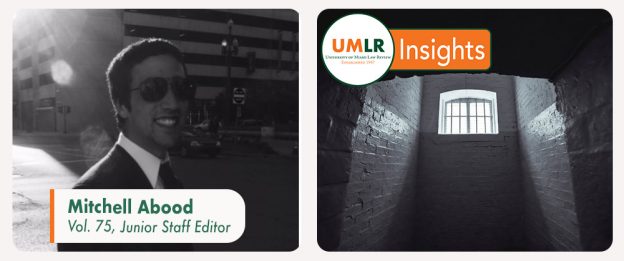MITCHELL ABOOD—Of the 142 facilities holding federal inmates, twelve are privately managed. While private prisons may have the undeniable benefit of reducing a states incarceration costs, private prisons present a number of problems that outweigh this benefit. Inmates in private prisons are less likely to receive parole, leading to longer periods of incarceration. Moreover, people of color are disproportionately placed in private prisons when compared to white prisoners. Taken together, private prisons aggravate racial inequality and continue a tradition of mass incarceration.
“For-profit” prisons in the United States date back to 19th Century California. However, the private-prison movement did not gain modern appeal until the 1980’s. During this era, the United States prison system was flooded with inmates, partially due to President Regan’s decision to escalate the War on Drugs. In response to increased demand for prison space, the Corrections Corporation of America (“CCA”), now CoreCivic, became the first private corrections company. Although several private corrections companies operate today, CCA remains the largest to this day. In 2016 alone, CCA generated more than $1.8 billion dollars in revenue.
The for-profit nature of these prisons is problematic as private prison interests are not necessarily in line with societies. Private prison, unlike their public counterparts, answer not to the people but to boards and shareholders, thus they have not only an incentive but a duty to their shareholders to maintain a profitable bottom-line. Thus private prisons have an interest in keeping incarceration rates high, which cuts directly against the best interest of our society.
The danger of this schism in objective does not exist in isolation and is exacerbated and magnified by mass incarceration and racial bias pervasive throughout the prison system. Today the United States Bureau of Prison comprises 142 facilities, and houses 151,646 inmates nationwide. However, the number of total inmates grows to over two million people when accounting for those held in state prisons. Considering this staggering number, it is no surprise that the United States leads the world in incarceration rate, imprisoning 655 of every 100,000 people. Comparably, Canada incarcerates only 114 of every 100,000 citizens. Thus, it is no surprise that the U.S. prison population has grown roughly 500% in the last 40 years. This exponential increase can be traced to a series of policies implemented the throughout the latter half of the 20th and early 21st centuries declaring a war on drugs, establishing mandatory minimum sentences, and more readily dolling out life sentences to those convicted.
This problem is only made worse by private prisons who tend to hold prisoners for longer periods of time than prisoners held in public prisons. It makes financial sense for private prisons to cut costs by hiring less experienced staff which leads to a higher rate of infraction given to prisoners. Prisoners held in private prisons are 15% more likely to receive an infraction than in a public institution. This negatively affects prisoners when they come before a parole board as prisoners with violations are less likely to receive parole than those without resulting in longer bouts of incarceration.
Even more problematic is how the criminal justice system disproportionately condemns people of color when compared to the white population. Although people of color make up only 37% of the nation’s population, they account for two-thirds of the prison population. Implicit racial bias in the criminal justice system is amplified by systemic socio-economic inequality leading to an incarceration rate for black men six times higher than their white counterparts. Not surprisingly, people of color are overrepresented in private prisons when compared to white Americans. This information coupled with the fact that private prisons tend to result in longer stays behind bars means that people of color are more likely to be arrested, more likely to be convicted, more likely to be placed in a private prison, and less likely to receive parole.
Despite the inherent risk, reliance on private prisons has only increased. Since 2000, the total population in privately run prisons has increased by 39%. Although the private prison population reached its peak in 2012, dependence on private prisons varies widely by state. While some states have banned their use entirely, other states, such as New Mexico, rely on private facilities to house over half of their inmate population. Unfortunately given these current trends, it appears that private prison facilities are not going away any time soon.
If left unattended and private prisons continue to supplant government run facilities, reducing or eliminating private prisons could become a logistical nightmare. New facilities will need to be established to house the inmates removed from private dominion. It is unquestionably easier to do this now while the private population is relatively small. If unaddressed and allowed to proliferate, the problems presented by a private prison system will only become that much more difficult to deal with.






